To help you find the perfect skateboard for you, we’ve put together this handy guide. Choosing the right skateboard is such an essential task for a budding skateboarder. The right skateboard can help you learn skateboard tricks more easily, ride fluidly and land lines. This handy guide will help you do all the above by teaching you how to choose a skateboard to suit your abilities.
The Skateboard Chart
The number one key to controlling your skateboard is getting the right sized one. The size chart below shows approximate sizes you should be looking at, taking your age and height into consideration. While it should give you a good idea of the size of deck you need, we still recommend going down to your local skate shop and standing on a few decks. If you’re looking to buy a smaller skateboard for a child, check out our range of children’s skateboards here .
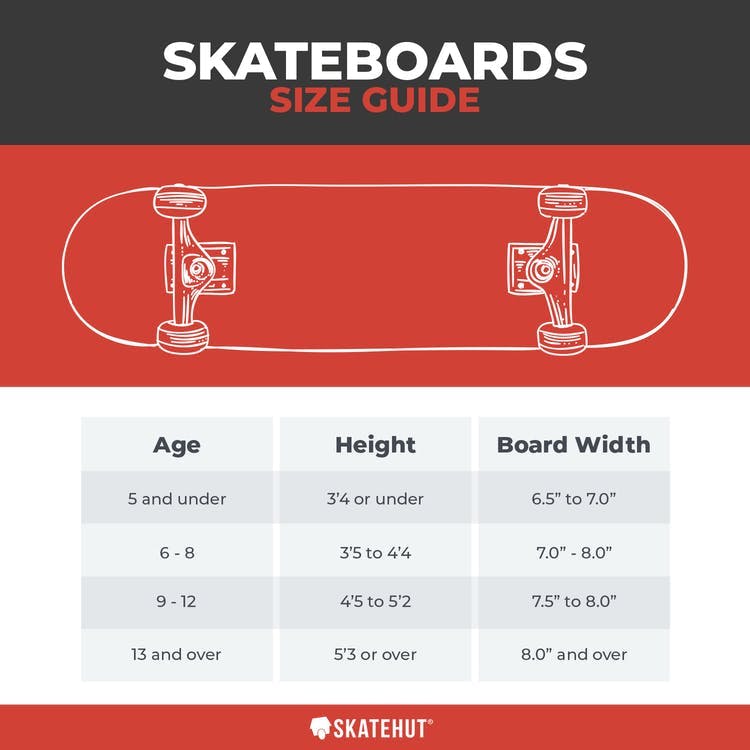
As you progress in skateboarding, you may find that a certain width of deck might become your preference. For example, a ramp/vert ramp rider may choose a wider deck for stability. A street or park skater may choose a thinner width of deck in favour of manoeuvrability.
Complete Decks
When you’re buying a skateboard you can either buy a complete skateboard where all the parts have already been assembled for you, or you can build a custom skateboard choosing all the individual components yourself, based on your preferences. If you’re a novice skater, then a pre-assembled complete skateboard could be a good option for you. They’re also perfect for traditionalists who have been riding with the same set-up forever.
Custom Skateboards
Many skaters enjoy building their own custom set-ups so they can tweak elements to suit their style. If you’re an experienced skater, the process of building a skateboard will only take 10-15 minutes. However, if you’re more of a novice it could be a minefield.
Skateboard Parts
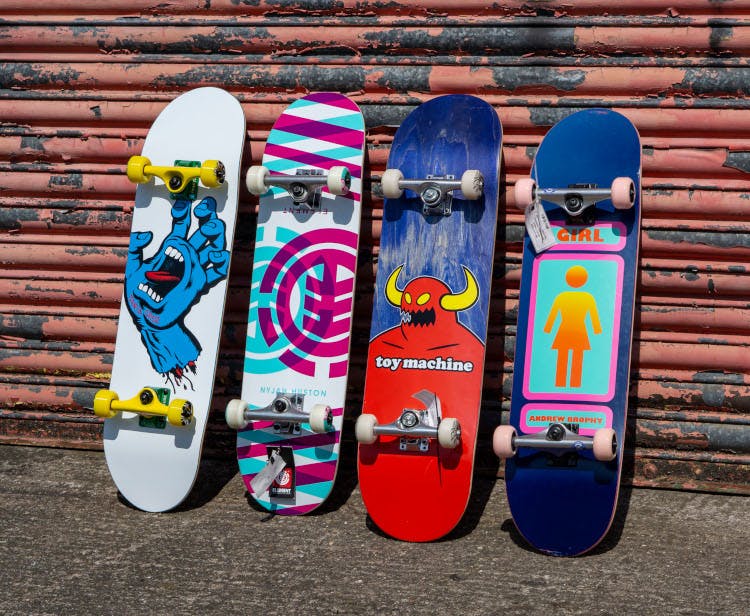
When building your dream skateboard from scratch, it’s important to know about all the component parts that make-up a skateboard. Here’s a quick run-down of all you should know.
Deck
A deck is the board or footplate that you ride on. It’s usually made out of 7 or 9 ply laminated maple sheets, but other options are also available. These often come with cool colours, graphics and styles to suit your taste. We have close to 1000 styles in our online store! View our full collection of skateboard decks here .
Grip Tape
This is a sandpaper-like material that sits on top of the deck. It’s completely anti-slip, allowing you to grip to the top of the board as you ride. It’s usually black, but colours can vary. In our collection we have stylish graphics, patterns and a multitude of bright colours. View our entire range of skateboard grip tape here . It’s essential you keep your grip tape clean for it to function as designed. You can change your grip tape when it starts to wear to ensure you maintain maximum grip.
Wheels
Wheels are usually made of Polyurethane (PU) and each skateboard needs 4. They’re known as rubber wheels and they come in a variety of sizes. The width of the wheel, or the contact area, is generally 32mm. This size does differ but is unlikely to affect compatibility with your board; instead it’s down to personal preference.
Cruiser Wheels
Cruiser style wheels are wider than standard skateboard wheels and offer more grip due to the larger contact area. These are often found on Penny skateboards and other plastic deck skateboards. These wheels are good for cruising, commuting or for use in bowl riding set-ups. If you’re looking for a larger diameter wheel then you should use high trucks or riser pads (we’ll discuss these later) as they provide you with better wheel clearance and stop ‘wheel bite’ where the deck rubs on the wheels.
Large Wheels vs Small Wheels
The diameter of the wheel is measured in mm. Smaller wheels are slower, while larger wheels are faster. For most standard skateboard set-ups, a 50mm-55mm wheel will be fine. Large wheels will have a greater top speed, but they’ll also take longer to accelerate. Smaller wheels will accelerate quicker but also have a lower top speed.
Soft Wheels vs Hard Wheels
In terms of durometer or hardness, each wheel is given a number between 70a and 100a. The higher the number, the harder the wheel. The grade of the wheel is known as the durometer. If you’re unsure whether you require a hard or a soft wheel, then we recommend a mid to hard wheel in the 90s as these are more forgiving when performing tricks.
There’s also a B scale which measures 20 points lower than the A scale, so an 80b is the equivalent of a 100a. Wheels using this scale are extremely hard, allowing for an increased hardness rating.
The softest wheels are great for rough surfaces where grip is needed to travel over cracks and pebbles. Anything given a rating of 101+ is a pro wheel with the least grip. These are ineffective on slick and rough surfaces.
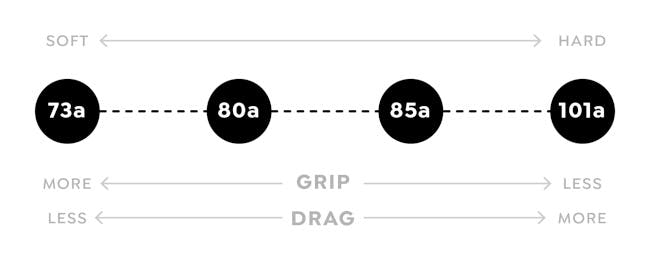
Some brands also offer wheels made out of their own specialised polyurethane. This is used to suit a specific surface. However, if this is the case, we’re always sure to label it in the product description and/or product title. You can find our great range of wheels here .
Trucks
These are an integral part of your skateboard and they’re likely to be the most lasting part. A pair of trucks are an essential part of a skateboard. Most trucks offered on our site come in pairs, but please check the product description carefully.
The width of the truck should correspond with the width of your deck, with the tip of each axle level with the edge of the deck. This will mean that the wheels are within a quarter of an inch of the edge of your deck. This will help keep the skateboard stable and will prevent over and under turning. This size guide should help you find the perfect trucks for your deck:
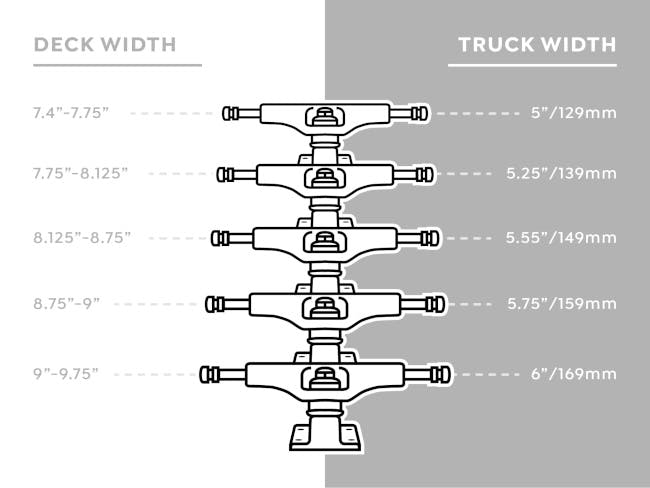
Trucks consist of a mounting plate, bushings, a kingpin, axels and a hanger. When assembled, it should look like this:
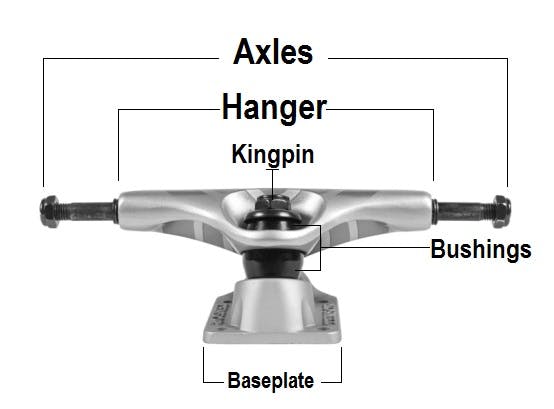
We’ll now explain each part in detail.
Base Plate
This is a flat plate that mounts the trucks to the deck. It usually comes with holes that will line up with holes on the skateboard deck. Truck bolts are then fitted through these holes to secure the truck in place, although these are not included with the trucks. Part of the job of the base plate is also to help evenly distribute the pressures of skating on the underside of the deck.
Hanger
The hanger is the large ‘T’ shaped part of the truck that holds the axles and forms the main body of the truck assembly. This is the part of the truck that will have the most surface contact and is used in many tricks, such as grinds and stalls. Hangers are often but not exclusively made of aluminium alloy, but most makes and models are similar in weight. Lightweight and titanium axles tend to be more costly.
Kingpin
The kingpin is the central bolt that holds the truck together. It feeds through the entire hanger into the baseplate. You can tighten or loosen the kingpin to affect the responsiveness of the trucks to better suit your riding style. If you’re not sure how to do this, just pop into one of our stores and we can show you!
Bushings
Bushings are the polyethene cylinders that fit around the kingpin and the deck plate. They’re also known as cushions as they support the truck as the board turns. With the help of bushings, you can make your turns much smoother and more accurate. Softer bushings increase turning response and feel looser. As a result, they’re preferred by lighter riders for cruising and carving. Harder bushings complement street and technical styles, giving a firmer and more stable ride for heavier riders. Most skateboards have bushings with medium hardness but you may want to try different bushings to sample different set-ups for your skateboard, they’re easy to replace and are widely available.
Bolts
Bolts keep your trucks mounted to the skateboard, and they can be fitted using skateboard multi tools . Bolts come in a variety of different sizes, lengths, colours and brands. People use different coloured bolts to help identify the nose and the tail of the skateboard, or just to customise their board. You can find all of our bolts here .
Risers and Shock pads
Risers are plastic plates which sandwich between the deck and base plate. They effectively raise the deck to prevent ‘wheel bite’, where the wheel touches the deck. For each skateboard, you should have two risers . We definitely recommend you get a pair - they’re so effective!
Shock pads are fitted in the same manner but are made of rubber to absorb the impact from landings and skating over rough surfaces.
Bearings
Skateboard bearings are used to mount the wheels to the axle, and they’re all the same size. The majority of bearings have an ABEC rating, which stands for Annular Bearing Engineers Committee. This is commonly mistaken for scale to rate how fast and strong a bearing is. Wrong. Watch this video to find out more about one of the most important parts of your skateboard.
Armed with all this information, you’re ready to find the perfect skateboard for you. Check out our full range of Complete Skateboards , or take a look at our Custom Skateboard Builder !
If you have any more questions, please don't hesitate to contact our customer service team at sales@skatehut.co.uk or drop us a call on 0121 501 1111.

